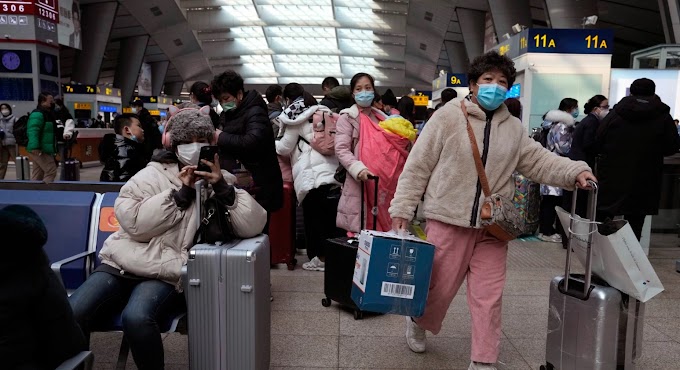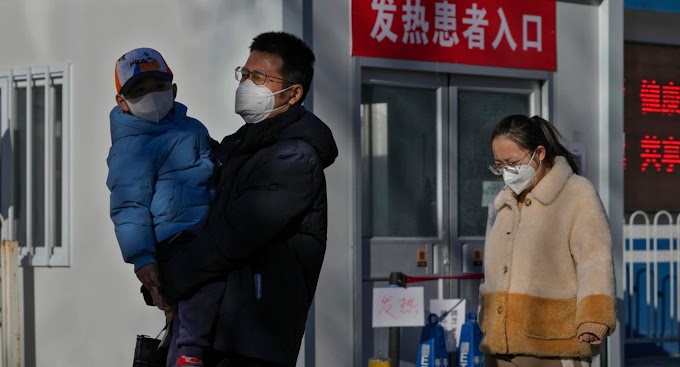Paying for epidemic prevention and control, the outbreak of the new crown in China highlights the lack of medical treatment preparation
 |
| In front of the fever clinic of a hospital in Beijing. (December 10, 2022) |
WASHINGTON —
In the past three years, when other countries in the world have been hit by the new crown epidemic, China has relied on its strong social control methods and insisted on a "clearing" policy, which made the Chinese people seem to resume most of their normal lives.
However, as countries emerge from the outbreak through mass vaccination campaigns, improving medical treatments and herd immunity, China's policy approach appears increasingly confused. On December 7, the Chinese government made a sharp turn in the epidemic policy, causing the epidemic to break out in many places across the country, especially in Beijing, where the medical system has been overwhelmed.
China had nearly three years to learn from the experience of governments around the world to get out of the epidemic and deal with the surge of new crown cases after the country opened up. However, health experts said that the authorities did not make good use of this window period, spending most of their time on epidemic prevention and control, and failed to help the public prepare for coexistence with the new crown virus.
China may usher in a large-scale infection wave in the next few months. According to an analysis by the London-based Airfinity medical risk company in late November, if China lifts strict epidemic restrictions, the new crown virus may infect as many as 279 million people and cause 2.1 million deaths, most of them unvaccinated elderly people.
Lawrence Gostin, director of the Institute of National and Global Health Law at Georgetown University, told Voice of America: "China's hospitals are full, although not as far as Western countries were during the outbreak of the new crown Delta (Delta) variant. to the extent that it is likely that China's health system will be overwhelmed by cases of COVID-19 in the coming weeks and months."
let go suddenly
Due to rare public protests and continued economic damage, on December 7, the Chinese government suddenly relaxed the epidemic prevention and control measures. Experts believe that the timing of China's opening up is not ideal. The medical system is not prepared for the infection wave, and the people are not mentally prepared.
For a long time, the Chinese people have been educated to be afraid of the new crown disease, which has led to an urgent influx of infected people into hospitals, further causing medical runs. Although the government has stepped up publicity efforts in the past few days to encourage home testing and treatment, community workers are understaffed due to large-scale infections, medical supplies, and even basic fever-reducing medicines are also in short supply.
Chinese media reported that pharmacies across the country have been sold out of anti-fever, cold and cough medicines, and it is also difficult to buy new crown antigen detection reagents, exacerbating the risk that seriously ill patients cannot receive timely treatment.
There are also media reports that China's nursing homes have not been notified in advance to stockpile relevant drugs and reagents, and there is no emergency plan mode for the elderly in the hospital to be transferred after infection. In addition, winter is the season for the outbreak of basic diseases of the elderly, which aggravates the difficulties faced by nursing homes.
Jennifer Nuzzo, director of the Pandemic Center at the Brown University School of Public Health, told VOA: "When there are many people seeking medical services at the same time, the quality of care everyone receives decreases. So this may increase the spread of the epidemic." The number of deaths to come includes not only those who died as a direct result of the virus but also those who may not have received the kind of high-quality medical care they could have received."
lack of vaccine rollout
Health experts say the extent of the wave of infections in China will depend largely on vaccination rates among the elderly. They warn that vaccination campaigns may come too late to prevent the current wave of infections.
The elderly are the most vulnerable group in the new crown epidemic. According to a study by the Chinese Center for Disease Control and Prevention, people over the age of 85 are 570 times more likely to die after being infected with the new crown than young people. Only 40% of people over the age of 80 in China have received a booster shot of the new crown vaccine.
For the elderly who have not had a booster shot, their last vaccination may have been a year ago, and their immunity has been greatly weakened. Because China's domestic vaccine uses inactivated viruses, it is not as effective as Western vaccines that use newer mRNA technology. Some studies have shown that three doses of vaccines in China are approximately equal to the effectiveness of two doses abroad.
Many families in China are hesitant to decide whether their elderly relatives should be vaccinated. Many believe that under China's massive lockdown, the elderly are less likely to be infected, and that vaccines may worsen their chronic diseases. At the same time, officials have not focused on the vaccination of the elderly before, and it was not until the end of last month that a document was issued to speed up the vaccination rate of the elderly.
Niels Graham, deputy director of the Atlantic Council's Geoeconomics Center, said: "Western countries want everyone to be vaccinated, but they are more concerned about the elderly. I don't think China has the same targeting. There is some general hesitation among the Chinese about vaccines based on past experience with and general mistrust of the Chinese medical system."
When China rolled out its domestic vaccine in early 2021, it recommended that people aged 18-59 be vaccinated, fueling claims that the vaccine is unsafe for the elderly. Some community vaccination sites are also reluctant to vaccinate the elderly because they cannot understand their medical history, which may lead to potential doctor-patient disputes.
Facing a large-scale outbreak, Sinopharm signed an import and distribution agreement with Pfizer this week to introduce the oral drug Naimatevir/ritonavir tablets (Paxlovid) for critically ill patients with the new crown. But for a long time, China was reluctant to introduce Western vaccines and medicines.
Graham explained: "Because they (the Chinese government) really want to insist that it is Chinese ingenuity, it is the decision-making of the Chinese government, not innovation from the West, that finally let them escape the worst epidemic. .”
Underinvestment in medical resources
According to the analysis, Chinese officials have used resources that should have been used to expand medical capabilities for endless nucleic acid testing and shelter construction, resulting in insufficient preparation of the medical system after the outbreak.
Graham told VOA: "When Western governments invest heavily in infrastructure, such as expanding intensive care units, buying more ventilators, and stockpiling a large number of treatments and drugs for the new crown virus, to really treat severe new crowns When there were cases, China focused its resources mainly on controlling the spread of the epidemic, building large-scale isolation facilities, using apps or other mechanisms to track the new crown.”
Chinese officials have rapidly expanded medical facilities in recent days. The number of intensive care (ICU) beds in the country has increased to 10 per 100,000 people from less than four a month ago, Chinese health officials said in a briefing last week. According to a model published by researchers at Fudan University in Shanghai in the journal Nature Science in May, the demand for ICU beds will reach 1 million at the peak of the outbreak, which is more than 15.6 times the capacity in China.
Even if China can take advantage of its infrastructure, finding enough well-trained medical staff will be a challenge, medical experts say. The rapid outbreak of the epidemic has caused widespread infection among medical staff in China.
"People with this virus need a high level of care, and you need people who can provide that care. So it's not just about building (medical) facilities, it's about having enough people," Nuzzo said.
According to statistics from the Atlantic Council, China has 3.1 registered nurses per 1,000 people, which is lower than developing economies such as Brazil, and far from Germany and other developed countries with 14 nurses per 1,000 people.
In fact, during the epidemic, China's investment in medical treatment resources has slowed down, and more resources have been turned to nucleic acid testing and the construction of shelters for isolation. According to the "Wall Street Journal" citing government documents, this year's budget for the construction of isolation centers has risen to 9% from less than 1% last year.
Economists at Goldman Sachs estimated in May that based on the frequency of nucleic acid testing every 48 hours and the coverage of 70% of the national population, China's annual expenditure on nucleic acid testing can reach as high as 2.5 trillion yuan.
In contrast, social health spending in China is slowing. According to Chinese official data, the total national health expenditure in 2021 will be about 7.5 trillion yuan, and the year-on-year growth rate has slowed to 4.74%, which is lower than the growth rate of 9.62% in 2020. At the same time, the increase in the number of hospital beds and the total number of medical staff last year also slowed down compared with pre-epidemic levels.
Although China is the most populous country and the second largest economy in the world, it does not spend much on health, which accounted for 6.5% of the gross domestic product (GDP) last year, which is lower than the world average of about 10% and lower than the 8.8% on average in OECD countries.
Urban-rural medical gap
About 500 million of China's 1.4 billion people live in small cities and rural areas. Medical resources in these places are far behind those of big cities such as Beijing and Shanghai, and they may be hit harder by the epidemic.
Beijing, the capital of China, has seen a surge in the number of 120 emergency calls and a 16-fold increase in the number of visits to fever clinics. However, many hospitals in rural China do not have fever clinics or ICU beds at all. According to statistics from the Atlantic Council, the average number of doctors per 1,000 people in rural areas of China is 30% less than that in cities.
Chinese health officials said this week that by next March, about 90 percent of township-level health centers will have fever clinics. But it may be too late. People across the country will embark on the journey back to their hometowns to visit relatives for the Lunar New Year in less than a month, which will put more pressure on the already weak medical infrastructure in rural areas.
Gostin expects big cities such as Beijing and Shanghai to be able to weather the surge in hospitalizations, while China's rural health system is much weaker.
"I expect huge problems in hospitals in rural China," Gostin said. "The extreme pressure on some hospitals will be palpable. In some places, hospitals may be overwhelmed, but it's kept secret to save face."







